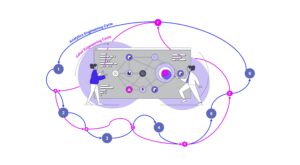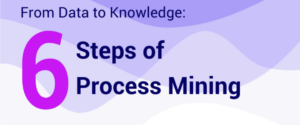“Process mining is an innovative discipline among Big Data technologies and makes it possible to analyse and map processes from data. This gives companies comprehensive insights into their processes,” says Gunther Rameseder from Celonis SE. In fact, process mining is already in use in many places, but its potential for process management is often underestimated. Used correctly, it creates a high level of process transparency.
What is process mining?
What distinguishes process mining from classical BI is the representation of data with the help of process flow diagrams. The reconstructed process data is presented graphically in a process mining tool, especially via such diagrams. Process mining does not model a specific process model, but only works it out. If, for example, you do not find your Kanban process in the technically validated process representation, you do not actually have the implementation of this concept of process organisation. In many tools, however, the reconstructed actual process can be compared with a theoretical process model (especially the target process).
Some providers for such tools are Celonis, Signavio, ProcessGold, PAF, Fluxicon and Lana Labs. These differ greatly from each other in terms of functional scope, cloud availability and enterprise capability. They also have different focuses partly because they come from different directions. While Fluxicon, for example, started as one of the process mining pioneers in 2009 with a desktop application, Signavio focuses on a completely cloud-based suite that combines process mining with process optimisation and automation to enable fast and targeted actions.
Technology or analysis methodology
Process mining is a buzzword that certain BI tool vendors want to hijack, but process mining is an analytical methodology that involves reconstructing processes from log data and other data traces in IT systems. “In our eyes, it is particularly important to understand that process mining is not an automated magic tool, but an analysis tool that requires a bit of experience and expertise on the user side,” says Anne Rozinat of Fluxicon.
Even if the word is obvious, process mining has hardly anything to do with data mining. The latter is a collection of methods for mathematical algorithms that independently extract structures from data that were not visible before. What is interesting, however, is that the mathematical data mining methods are now also finding their way into process mining – but more on that later. At present, process mining is a procedure that requires at least one data engineer to merge data into a protocol via SQL or a programming language such as Python.
Process mining and business intelligence will grow together
Process mining and business intelligence have mainly been discussed and applied separately. Business intelligence deals in particular with the structured provision of at least daily updated dashboards that provide quantitative information about the current company situation. Business intelligence is classically retrospective or can report on the current situation in near real time, as is the case with process mining. Process mining is a sub-discipline of BI that focuses not on general KPIs but on process-specific KPIs.
“Today, it is impossible to imagine the process world without process mining. In the future, we will see a much stronger dovetailing and integration with ERP, BPM, RPA and other systems,” comments Rudolf Kuhn, co-founder of ProcessGold AG.Some ERP system providers are already reacting to the trend and are working on in-house event logs, or protocols suitable for process mining, in order to lower the hurdles for process control.
The outward appearance of business intelligence is characterised by dashboards that use BI tools to present information with tables, bar charts and histograms. They show data in absolute and relative values as well as their distributions. Typical providers of BI tools are QlikTech, MicroStrategy, Tableau and Microsoft with its currently popular tool Power BI.
With its product PAFnow, the tool provider PAF (Process Analytics Factory) relies entirely on the Power BI tool, which is supplemented by a PAFnow plug-in to become a powerful process mining tool. This plug-in approach has the advantage that the user can directly use the widely used BI tool Power BI, which also has a huge user community, for process mining.
Lana Labs relies on open interfaces for integration to enable seamless integration into individual IT landscapes. Thanks to its versatile interfaces, Lana Labs’ software allows process mining results to be easily integrated into the company’s existing BI dashboards (Qlik, PowerBI, Tableau, etc.).
In the future, BI systems will also be supplemented with predictive analyses and thus enable a view – albeit slightly blurred – into the near future. This includes, for example, forecasting models for turnover, warranty claims or purchasing requirements.
Detecting anomalies in processes with AI
In the future, process mining will also be supplemented by methods from data science. The goal is to use machine learning to detect anomalies in process chains, for example, which can play a role in process optimisation or fraud detection. Process mining thus becomes process analytics. So far, only the market leaders in process mining tools have integrated the first machine learning functions.
Celonis is consistently developing its process mining technology further and is increasingly focusing on machine learning. With process mining in combination with machine learning, it should be possible to generate even more comprehensive analytical insights. Process analyses no longer only pursue the goal of analysing past processes, but should also enable future-oriented forecasts. For example, the Celonis Action Engine can be configured in such a way that a request for action is automatically sent when a deviation from a certain target lead time is forecast.
But the other tool providers are also working on integrating machine learning. Through its R/Python integration, Lana Labs enables users to access diverse AI algorithms in addition to their own machine learning functions and to extend process mining with their own developments. According to CEO Tobias Rother, PAF is also moving in this direction: “In PAFnow, we successfully combine artificial intelligence with modern process mining methods to automatically analyse processes, obtain targeted insights, review business processes and sustainably improve the performance of processes by triggering concrete actions from PAFnow.”
Independence from tool providers thanks to data engineering
Data engineers develop data warehouses and make data available through specific channels in desired formats. This distinguishes them from data analysts, who analyse data statistically, and from data scientists, who apply statistics even more extensively and also develop machine learning models to detect patterns in data.
The data engineers play the most important role, especially at the beginning of the process mining implementation. They identify the relevant data in the databases – the data backend of the ERP, CRM and all other IT systems – and they merge and transform it into the aforementioned log-like structure of an event log. This event log is the data basis for the process mining tools.
This is done via data flow chains (ETL or ELT), which automate the flow from the source systems via fusion and transformation to the process mining tool.
Most software providers for process mining try to implement many standard processes in the better-known ERP and CRM systems, such as those from SAP, Microsoft or Salesforce, in terms of event log generation and data provision as their own standard as a connector. On the one hand, this standard connection is intended to facilitate entry into process mining and aims to provide a plug-and-analysis solution. On the other hand, these providers also try to establish their solution and create barriers to entry for a possible change of provider.
Companies that want to get started with data-driven process analysis can also take data provision into their own hands via their own data engineers. Companies that have quite individual processes or use a less common ERP system have no choice but to rely on data engineers anyway. If some aspects of the data formats and the provision of these data are taken into account when creating the event log, it can be used universally. The technical organisation thus remains open to any process mining tool and makes itself independent of specific providers.
Process mining has a future
While process mining and business intelligence are growing together, the opposite side, namely ERP and other IT systems, are also partly already trying to take a step towards this analysis methodology and at least facilitate the provision of data. Furthermore, Robotic Process Automation (RPA) will also become more closely intertwined with process mining.
“The use of process mining is essential for digital transformation. With process mining, we create digital twins in heterogeneous IT landscapes for our customers in production, for example, and minimise the risks and expenses of IT system migrations,” explains Thomas Baier, CEO of Lana Labs GmbH.
Current providers of process mining, such as Celonis based in Munich, have already been working on combining process mining with business intelligence for years. On the other hand, providers of established BI tools, such as PAFnow with Microsoft Power BI, are holding their own and incorporating functions of visual process representation.
In any case, it is an analysis methodology that will become increasingly important in the coming years and already plays a decisive role in process optimisation and auditing in many companies. “Interest in process mining will not wane. On the contrary, together with process modelling and automation, it will be an integral part of every modern process management initiative in the future,” Gero Decker, CEO of Signavio, assesses the trend.
The professional entry into process mining
To get started with process mining, there is now a good selection of tool providers with different strengths and weaknesses. Which tool is the right one for a company depends strongly on the expected use cases, the integration into the company and into existing IT and BI infrastructure as well as the demand on the type of analysis, e.g. from short-term projects to long-term monitoring of processes with analysis in almost real time.
The respective tool providers often offer training or so-called boot camp events to introduce the topic. A more neutral event is the ICPM Conference, which focuses on process mining as an analysis method every year.
There is also good online material to get you started. Fluxicon, for example, publishes a process mining book online for an easy start, which presents the tools for this still very new process analysis discipline, even for beginners.
Another option is to call in data experts who already have experience with process mining and accompany the employees parallel to the introduction. Ideally, these people should come from the company’s specialist department or industry. Ideally, these people have experience with more than one tool provider so that independent solutions can be found from the beginning.




